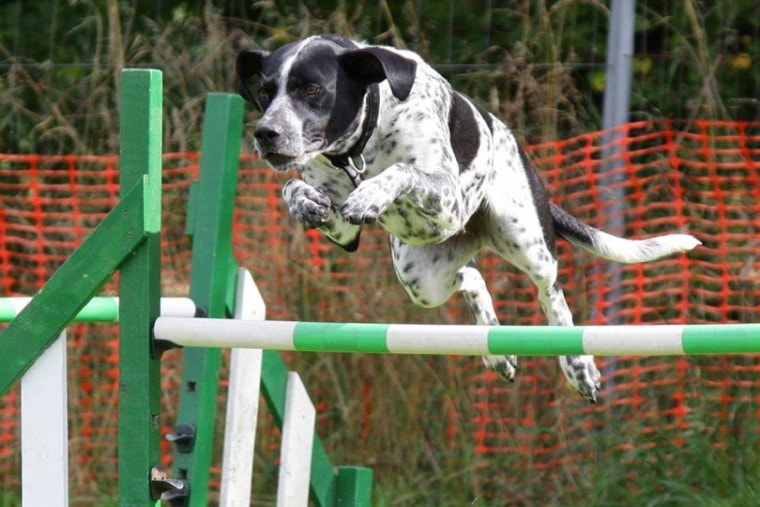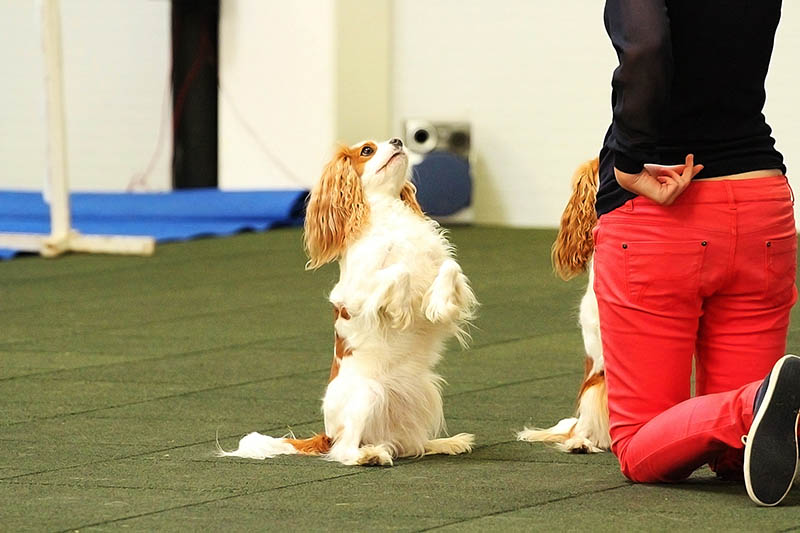
For owners with highly active dogs, agility courses are among the best ways to give them a challenge, test your teamwork, and drain some of their boundless energy reserves. You don’t have to sign up for competitions either. If you have the space, you can set up a personal agility course at home and do it just for fun.
The first steps into learning agility can be a little daunting, though, especially if you’re new to dog ownership. These 11 tips will help get you and your dog on the right track for agility training.
The 11 Tips to Train Your Dog in Agility
1. Start Early
All trainers have different methods of training their dogs. One thing that we can all agree on, though, is how essential it is to start as early as possible. Since some of the agility obstacles will be too much for your new puppy until they’re a little older, you should also be working on socialization, house training, and basic commands.
Obedience is essential for success in agility courses. When you run the course, you won’t be allowed to touch your dog to guide them through the obstacles. If they don’t listen to your commands, you won’t get very far.
Once you’ve got the basic commands down and before you start with agility training, start working on the tougher obedience commands. Getting your dog to pay attention and to come when called, especially under distraction, will stand you in good stead for success.

2. Stay Positive
Training dogs, even if they’re a highly intelligent breed, takes determination, consistency, and plenty of dedication. Whether you’re teaching your dog basic commands or complicated agility courses, taking your time and staying positive is the way to succeed.
Short sessions filled with positive reinforcement, whether it’s playtime or a tasty treat, will keep your pup interested and give them a break from learning. Not only is positivity a great way to ensure that both you and your dog enjoy training sessions, but it also helps strengthen the bond between you.
No matter the breed of dog you have, they’ll be delighted to know that they’ve made their favorite person happy.
3. Teach Them Tricks
Most of the tricks that you can teach your dog are good practice for many of the obstacles used in agility courses. It might seem like overkill to teach your dog so many different tricks, but the more knowledge they have about different things, the better equipped they’ll be to handle the obstacles that they’ll face later.
For example, teaching your dog to touch your hand or a specific object will help them succeed at contact obstacles. Teaching them to “spin” or chase their tail will help develop their flexibility for the weave poles and other tight corners. Even teaching your dog to bow is a great way to add in a few stretches to help your pup fly through the obstacles.

4. Start Small
After teaching your dog how to behave and listen to you, it’s time to start tackling the obstacles that you’ll face during agility courses. The initial obedience training will help make sure you don’t start teaching your dog too early and will teach them to trust you when they’re faced with new things. Still, it’s important to start small and take each step slowly.
Starting small also allows you to try out a few simple obstacles without purchasing actual equipment. To begin, you can teach your dog to sit on an overturned crate as practice for the pause table or even teach them something as simple as stepping between the rungs of a ladder lying on the floor. These will help slowly familiarize your dog with the obstacles and help you get a feel of how well they’ll do when faced with the real thing.
5. Introduce Contact Obstacles

Everyone thinks of jumps and weave poles when they think about agility courses. Neither of these obstacles requires physical interaction from your dog, though. Contact obstacles are different because they require your dog to touch a certain spot at the beginning, the end, or both to clear it.
The A-Frame, seesaw, and dog walk are all contact obstacles. With all three, you must teach your dog to touch the contact areas to conquer them. You can do this by leaving treats in the contact area to make sure your dog has to step inside the spot to reach them.
Taking it slow here is important. You can’t jump straight into expecting your dog to be comfortable with an A-Frame set at its maximum height from the get-go. Start with the lowest height, and use plenty of positivity to teach your dog not to be afraid.
6. Introduce Moving Obstacles
The seesaw, or “teeter-totter,” is one of the most nerve-wracking obstacles that your dog can face. Not only do they have to walk up a slope, but the plank will shift as they walk over it. Dogs don’t have much awareness when their backend is concerned, and many canines don’t like the ground shifting beneath them. With the seesaw, however, they have to reach the end and touch the contact area before dismounting.
Start with a wide piece of board placed on a brick. This will give your dog plenty of space to practice keeping their balance while introducing them to the sensation of the board moving beneath them.
Take it slow here. Reward positive interactions with the board, and only increase the height when your dog is comfortable with the obstacle.
7. Introduce Tunnels

Tunnels are relatively simple to teach. However, while some dogs dart through tunnels with no problem, others can be timid around dark and closed spaces. This is another area where teaching your dog to not see the tunnel as something scary is important.
To start, keep the tunnel small and straight. You can use a big cardboard box or two dining chairs and a blanket. Don’t force your dog to enter; instead, reward curiosity and coax them through. You can do this by dropping treats inside the tunnel and then sitting at the other end and calling them. Or, if the tunnel is big enough, you can get them to follow you through it.
You can tackle large tunnels with bends once your dog is comfortable with the smaller, less intimidating obstacle.
8. Introduce Jumps
Some of the obstacles used in agility trials shouldn’t be attempted by dogs that are too young, such as jumps. It’s important to consider the age of your puppy and their jumping ability to avoid injuries. When in doubt, it’s better to underestimate than set the jump too high.
This is an easy one to learn at home, at least. Set a broomstick or plastic pipe horizontally on two objects. Don’t secure it down, as you want to make sure it falls if your dog knocks it. Keep it low enough for your dog to handle, even if they barely have to step over it or it’s lying flat on the floor.
Here, you can jump the pole with your dog or place the obstacle in a hallway to prevent them from avoiding it. Remember to take your time and don’t push too hard.
9. Introduce Weave Poles

One of the hardest obstacles for your dog to learn is the weave poles. They need flexibility and body awareness for success, two things that many dogs aren’t well known for. Teaching them how to conquer this obstacle can take several months and shouldn’t be rushed into.
When you first start, don’t worry about keeping the poles in a straight line. The idea is to teach your dog to walk through the spaces first. Stagger the poles so you can walk a straight line between them. As your dog becomes more familiar with the poles, you can start to close the space.
Slowly, as you get closer to a straight line of poles, your dog will learn how to bend properly to complete the obstacle. Once they’ve mastered weaving between them, you can work on building up speed.
10. Put It All Together
It can be easy to fall into the trap of getting excited about your dog’s success and push them to complete a course before they’re ready. It’s important to ignore the urge to do so. There are many obstacles for your dog to learn, and before you attempt a full course, they should master the individual obstacles.
Once your partner is comfortable with all the obstacles, slowly put the course together. Don’t jump into attempting all the obstacles at once, though. Instead, introduce them one at a time so your dog can slowly figure out how to switch from one to the other.
It’ll help you figure out the timing for your commands for each obstacle too. You need to find the middle ground between clearing the first obstacle and before they get distracted or attempt the wrong one next.
11. Desensitize Them to Distractions
If you’re not interested in competing with your dog, once you’ve mastered the whole course, you can challenge your dog to different layouts for fun. For competitions, though, there’s one more step that you should take before finding your local events.
Competitions of all types are crowded, loud, and generally chaotic. Mastering each of the obstacles will only get you so far if your dog is too distracted or frightened by the audience to listen to you. Desensitizing your dog to distractions shouldn’t wait until you’ve mastered the full course.
As soon as your dog knows how to conquer each obstacle, you can put on shows for your friends or even try setting up a short course at your local dog park. You can even try taking classes in agility course training. With all the other dogs around, yours will soon learn to focus on you and forget to pay attention to distractions.
Final Thoughts
Training your dog in agility takes time, commitment, and determination. It’s a learning curve for both you and your puppy as you learn to work together. Not only is it a way to relieve excess energy in high-energy breeds, but the challenges presented by each course also mentally stimulate your pup and prevent boredom. It might take a while to master each obstacle, but the rewards are more than worth the effort. You might even win a few trophies too!
Related Read:
- How Much Does Dog Agility Cost? (Training & Equipment)
- PetSmart Dog Training Review: Costs, Effectiveness, and FAQs
Featured Image Credit: woodsilver, Pixabay







